The customer experience plays a crucial role in digital transformation. Or better: many digital transformation initiatives arise from pain points, business/innovation needs and growth/transformation imperatives on the customer (experience) side of business.
These are caused by the increasing importance of an end-to-end customer experience improvement approach, which in turn is, among others, caused by changing customer expectations and customer experiences offered by the best-in-class.
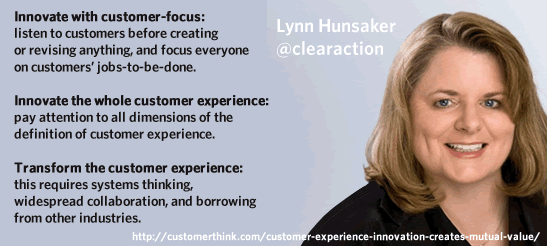
Sometimes, in a digital transformation context, organizations look mainly at what has become known as the digital customer experience, although digital transformation projects in customer experience, certainly (can) stretch far beyond the sheer digital dimension. Let’s not forget that the customer is one, even if it makes sense to look at the digital customer experience.
We can give literally hundreds of examples, if not thousands, on how customer experience matters in several industries, digital transformation, future growth and so much more and maybe we’ll do an overview in the near feature, focusing on some verticals, specific processes and business functions, and some cases.
Mutual value and customer experience transformation and innovation as the middleware for sustainable business results
But, for now, let’s look at the primary reasons why the customer experience, understanding the customer journey and optimizing user experience are essential in a context that every executive will understand: money.
On top of individual cases, there are several pieces of research, looking at the impact of an ongoing focus on customer experience optimization and innovation. One example is mentioned in an extremely insightful post by Lynn Hunsaker (founder of CX company ClearAction), published on Customer Think.
The topic of the post: customer experience innovation (which we’ll cover later) and the creation of mutual value. In these connected times we would even say exponential and networked value. Where customer value meets business value and beyond.
“Customer experience innovation”, Lynn writes, “creates mutual value for anyone in the holistic definition of customer, regarding any aspect of their experience with a solution, with a focus on the customer’s jobs-to-be-done”. Holistic. Enterprise-wide. End-to-end. I love it.
In a 4-year study, Lynn found that, I quote, “systemic customer experience improvement and innovation were under-used building-blocks in the cause-and-effect system of customer experience optimization”. And she adds a nice comparison by calling company-wide improvement and innovation of customer experience (transformational indeed, as you can read further in her post) the middleware for sustainable business results. I simply love that image, taste it again: “the middleware for sustainable business results”.
What to keep in mind about digital transformation and the customer experience
However, back to the core theme of this article: digital transformation and the customer experience. There are some important things and caveats to keep in mind when looking at your digital transformation strategy and the customer experience. Below you can find a few.
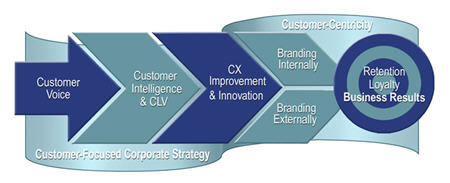
A holistic and enterprise-wide approach
Digital transformation on the customer experience level is not just a matter of the front-end and customer-facing functions, let alone touchpoints. It’s a matter of the whole organization and requires involving the back-end as well.
It also requires an enterprise-wide approach or better: a roadmap towards such a holistic approach. In practice you need to start somewhere and stage but the end goals require that sooner or later it is done. The enterprise-wide approach is at the same time a starting point and transformational stage.
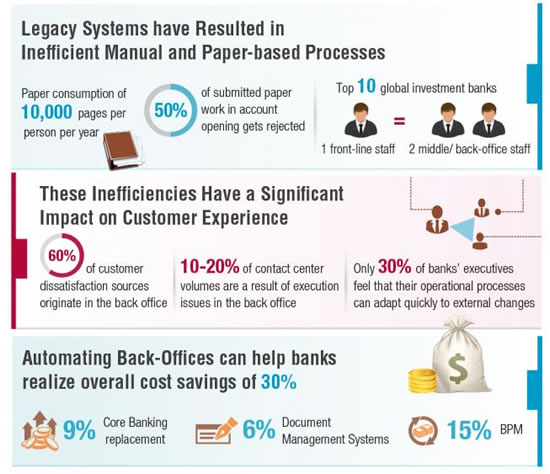
People first – the customer experience and digital transformation priority
Integrating the back-end and front-end is just part of a transformational challenge on the level of technology and processes.
People are by far the most important component of customer experience management and of a holistic customer experience optimization approach, both internally as – obviously – regarding the customer. You can imagine a scenario in which a customer-related digital transformation effort is done to improve the customer experience, without the customer using any digital technology in that process, even if it becomes increasingly rare as digital becomes pervasive in the customer journey and experience, regardless of age and segments.
When digital customer-facing processes and interactions, as well as customer experiences, are key in achieving the customer experience optimization goals, make sure these digital touchpoints and “tools” are so valuable that customers WANT to use them instead of less effective and more expensive ones they prefer today.
Knowing the why behind each why
Managing the customer experience (in the true sense of designing customer interactions to meet/exceed customer expectations) and optimizing it leads to clear and tangible results for the business. However, each organization is different.
The “why” of optimizing the customer experience (patient experience in healthcare, citizen experience in government, etc.) is essential. The question to ask is not just what and how, it’s also why, beyond the – for me – obvious reason that satisfied customers are simply good business and that customer service excellence and experiences are the basis. Individual pain points and answers to the “why” can include increasing customer churn (why?), more dissatisfied customers (why?), anything really with the why beyond the why being key (and often being related with disruptions in your market, changing customer expectations, increasing competition, a lack of innovation, etc.). In other words: improving processes and digitizing to enhance customer experiences is one thing, transformation and the reasons for it another.
The responsibility for the customer experience
The customer experience only belongs to the customer an, as said, one way or the other will require an enterprise-wide approach.
Obviously, this can happen in a staged way and assigning responsibilities but always with a clear roadmap for the end goals in mind. Digital transformation is not digital marketing transformation, it’s not customer service transformation, it’s all of that and more in a customer experience context.
Customer experience optimization and process optimization must go hand in hand
Processes, data, agility, prioritization, technology, integration, information, business and IT alignment, digitization etc. all matter but are conditions for better customer experiences.
What matters more than technologies and even processes is people as mentioned previously. None of the above is a guarantee for customer experience enhancement. However, they go hand in hand and work when connected for a common purpose. In a survey, conducted by AIIM, elements regarding the customer experience, including accurate and consistent customer communication, fast customer response on all fronts and providing best-in-class customer experience were mentioned more often than other future business success drivers such as process automation.
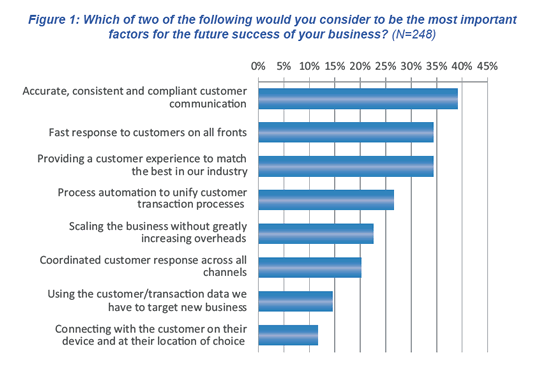
However, the process aspect, human element and customer experience part go together.
The exception becomes the rule
From a customer service and contact center perspective, there are several challenges. On top of the need to redefine – and “sell” the role of the contact center in the customer experience equation, the digitization of processes focuses on the automation of routine tasks first (with a broad mix of technology available, including self-learning systems) and, as Nicola Millard states, the contact center of the future will have a more pro-active role and the customer experience and value propositions will shift more towards complex customer requests.
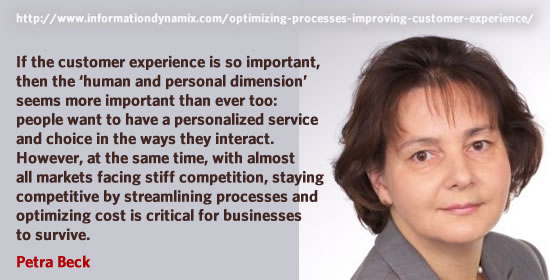
This shift will also play a role in the metrics used: from typical contact center metrics as we know them today towards more customer experience oriented metrics.
Measurement across the board: speaking a common language
As just mentioned, referring to the blog post of Nicola Millard, there is a shift in the way we will measure customer service and contact center quality. Within a broader digital transformation context, this is essential to take into account when it boils down to the customer experience.
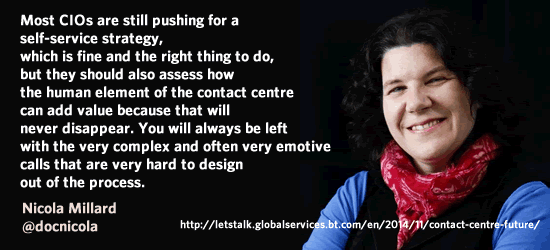
Enterprise-wide transformations need enterprise-wide metrics and KPIs. Or in other words: amidst the avalanche of data and often fragmented customer-related measurement possibilities, it’s hard to get a holistic view. Integration requires focusing on common goals. It’s the same as in the implementation of marketing ROI programs: speaking the same language, across all marketing-related activities. Only here it’s in a customer experience context. We have to dare let go of pure transactional and internal KPIs and move towards a mix of KPIs and metrics that are closely related to the customer. Transformation is also about that. NPS (as a system) is one way, another one that gains traction is the Customer Effort Score. In practice, often a mix is used. From an enterprise-wide or holistic perspective of course we look at customer satisfaction, customer lifetime value and I would add leakage but that’s for a separate article.
This list is of course far from exhaustive. Also consider:
- The role of IT and various enabling technologies such as artificial intelligence (routing, IDR, knowledge base,…), multi-channel inbound communications, unified communications and collaboration, virtualization, videoconferencing etc.
- The oh so crucial role of employee training, engagement and enablement, which we’ll cover in depth in another article.
- The fact that the lines between online and offline blur and that it’s not all about self-service etc. but also about digital transformations in offline and hybrid contexts (think retail stores, for instance).
Last but not least: we’ve talked about the people dimension. It’s so important that we’ll cover it separately as well. Staying close to the customer is not just a matter of metrics or the customer experience as such.
Regardless of the use of digital technologies and the areas of digital transformation and virtualization; until further notice people will continue to have personal interactions when, where and how they want.
Originally published on InformationDynamix

